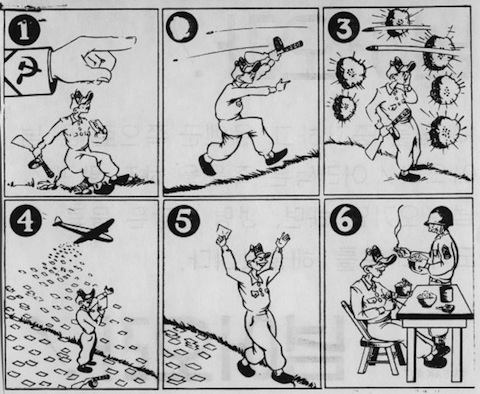
Back in 2009, I meditated upon the question of whether or not wartime propaganda leaflets are actually effective at weakening an enemy’s resolve or ability to flight. The main takeaway was that design really mattered, as only certain kinds of leaflets—those with clear messages that eschewed graphic imagery—made a real impact on recipients.
Ever since writing that post, I’ve been interested in the nuances of propaganda leaflet design. So imagine my joy upon discovering this stupendous collection of leaflets from the Korean War. My favorite of the lot is depicted above, an appeal for North Korean soldiers to lay down their arms and enjoy a nice, hot meal provided by the decent folks at the United Nations. A bigwig from the Psychological Warfare Division, Albert G. Brauer, explains the simple rationale behind the cartoonish approach:
One problem we were confronted with was how to reach the large (80 percent) illiterate target audience. This so-called “Sad Sack” leaflet, named after a popular G.I. comic character of World War II, proved to be the answer.
In this companion critique of the military’s leafleting program, Brauer claims that approximately 70 percent of the materials produced by his division were wholly ineffective, primarily because they conveyed messages that couldn’t be parsed by North Korean and Chinese soliders. The most common misstep? Portraying the concept of “death” in a way that didn’t make sense to the intended recipients. That, and trying to convey messages that were just way too complex to get across in a single sheet of paper. A case in point was a leaflet that tried to explain that soldiers should be skeeved out by the fact that their commanders forbid them from reading foreign propaganda. Big mistake, confesses Brauer:
Intelligence reports indicated Communist officers and cadremen were continuously forbidding men to read UN leaflets. This leaflet was designed to counter this. It was considered such a good leaflet by me and others that it was not tested on POWs prior to dropping. Later a survey was conducted and to the question: What does this leaflet mean to you, a large percentage of POWs answered, “If you read leaflets your officers will punish you.” Needless to say, we stopped dropping it.
Worth noting that Brauer later became a high-school government teacher. I bet his propaganda experience actually served him well in dealing with hormone-addled American teenagers.


Jordan // Aug 5, 2011 at 12:39 pm
The Law of Unintended Consequences would seem to lean heavily on their efforts.
Captured Shadow // Aug 5, 2011 at 2:33 pm
You always have to check your advert with the intended audience to see if the message is getting across. I wonder if POW’s gave good advice regarding effectiveness, or if they lied to the captors to sabotage their efforts.
Commerce Above All | Microkhan by Brendan I. Koerner // Aug 30, 2011 at 9:46 am
[…] noticed a recent Microkhan obsession with visual communication—particularly the way in which simple illustrated material can be used to convey complex messages. This is an interest that dates back to my first exposure to […]